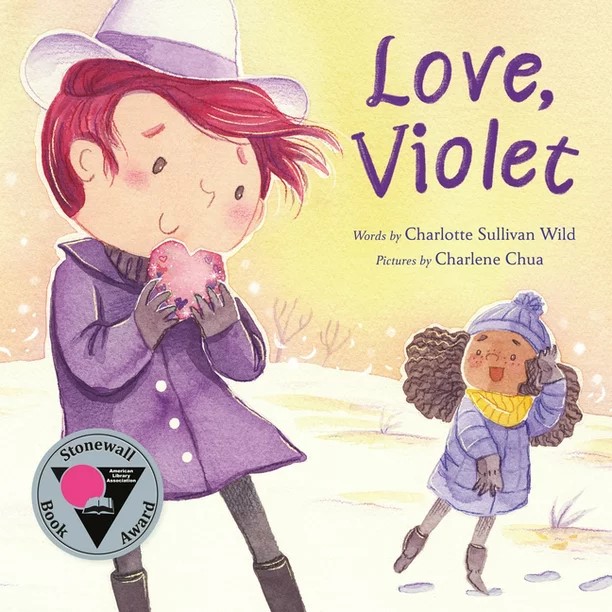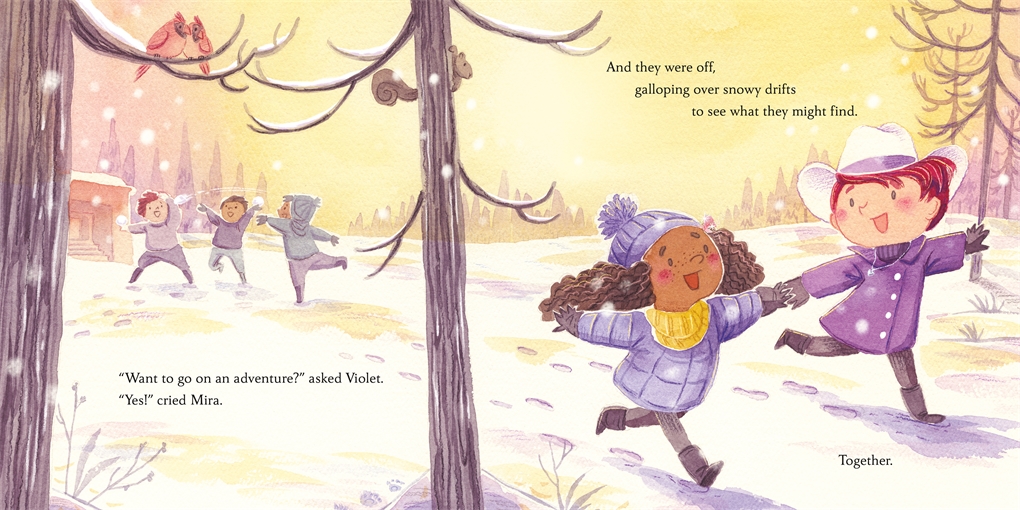
Inclusive Children's Book Teaching Guide
Love, Violet
What is this book about?
Only ONE person makes Violet’s heart skip!
Of all the kids in Violet’s class, only one leaves Violet speechless: Mira, the girl with the cheery laugh who races like the wind.
If only they could adventure together! But every time Mira comes near, Violet goes shy.
As Valentine’s Day approaches, Violet is determined to show Mira just how special she is.
Who is depicted in this book?
- Children who may be LGBTQ+
- Children who transcend gender stereotypes
What early childhood themes and concepts does this book explore?
- Social play behaviors (playing make-believe, walking, running, exploring the playground)
- How we can communicate feelings (homemade gifts, writing, play)
- Common emotions (love, fear, embarrassment, excitement)
How does this book support anti-bias education?
Love, Violet celebrates expressions of love and affection for same-gender individuals who make us feel good. This sentence from the book is a good example: “Only one made Violet’s heart skip—Mira!”
While the text can be read as an expression of love between friends, it also has the potential to be read as an LGBTQ+ story. Consider that the story focuses on Violet’s fears about expressing her feelings and her struggle to do so. Make sure to include other books in your library that celebrate identity without struggle.
Depending on how the book is shared or used—and the developmental level of the children—the images and text may be used to support the following core goal from the book, Anti-Bias Education for Young Children and Ourselves:
Diversity—Teachers will promote each child’s comfortable, empathetic interactions with people from diverse backgrounds so that children will express comfort and joy with human diversity, use accurate language for human differences, and form deep, caring connections across all dimensions of human diversity.
How can this book be used to meet early childhood learning standards?
For all ages
Use Love, Violet to meet early childhood literacy standards
For children from birth to age three
Teaching suggestion: Point out familiar activities and forms of play that Violet and her friends engage in throughout the book. Even the youngest children can point to, name, or imitate these examples.
What Illinois Early Learning Guideline does this meet for children from birth to age three?
Developmental DomainLanguage Development, Communication and Literacy
Standard: Expressive CommunicationChildren demonstrate the ability to understand and convey thoughts through both nonverbal and verbal expression.
Indicators for children:
- Begins to use telegraphic speech such as “kids play” (16–24 months)
- Begins to use pronouns and prepositions (21–36 months)
Teaching suggestion: Point out and imitate Violet’s emotions as they change over the course of the story. Model and encourage the children to identify words that communicate different emotions.
What Illinois Early Learning Guideline does this meet for children from birth to age three?
Developmental DomainSocial-Emotional Development
Standard: EmpathyChildren demonstrate an emerging ability to understand someone else’s feelings and to share in the emotional experiences of others.
Indicators for children:
- Demonstrates awareness of different emotions and feelings during play (16–24 months)
- Communicates how other children may be feeling and why (21–36 months)
Teaching suggestion: Talk about the concept of rejection. Are there times when the children have been afraid of rejection? How does it feel to be rejected? How can we express friendship and love? How can we make our friends feel included and important to us?
What Illinois Early Learning and Development Standards does this meet for preschoolers?
Social/Emotional Development Standard31ADevelop positive relationships with peers and adults.
Benchmark 31.A.ECa:
Show empathy, sympathy, and caring for others.
Benchmark 31.A.ECb:
Recognize the feelings and perspectives of others.
Benchmark 31.A.ECe:
Develop positive relationships with peers.
Teaching suggestion: Ask the children to focus on Violet’s range of emotions throughout the book (nervous, excited, worried) and discuss how the words and illustrations convey Violet's different emotions.
What Illinois Early Learning and Development Standards does this meet for preschoolers?
Language Arts Standard1ADemonstrate understanding through age-appropriate responses.
Benchmark 1.A.ECd:
Identify emotions from facial expressions and body language.
See inside this book.

What other resources are available?
Visit the author's website for a variety of resources.
The Pride and Less Prejudice website offers a read-aloud guide for older preschoolers and elementary school students, an author interview, and a read-aloud video.
